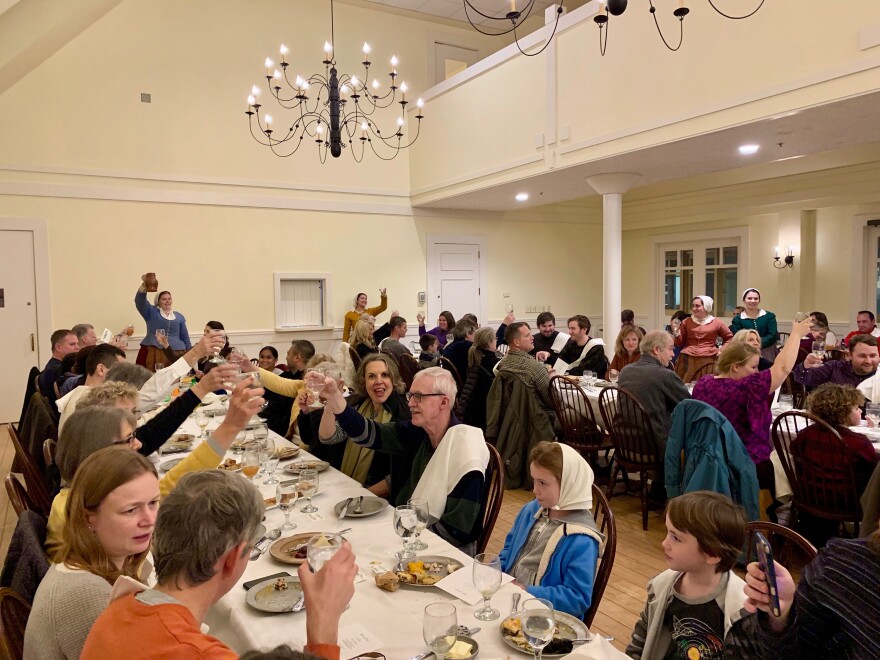Later this week, most of us will sit down to a Thanksgiving meal, just as the Pilgrims’ did after their first year in Plymouth. But Thanksgiving as we know it today is much different from the one the Pilgrims celebrated almost 400 years ago.
Plimoth Plantation offers living history re-creations of that period in American history. One of their missions is to educate visitors about how the first Thanksgiving really happened.

“For one thing, the first Thanksgiving was three days long,” said Kathleen Wall, a Foodways Associate at Plimoth Plantation.
And it most likely occurred in late September or early October. The day that came to be known as Thanksgiving didn’t become a national holiday until 1863, under President Abraham Lincoln.
“The Pilgrims are actually an afterthought,” said Wall. “First, there’s Thanksgiving to celebrate the nation together. And remember, Abraham Lincoln is President during the Civil War, so the nation is not together. And this becomes in some ways a northern holiday. So right from the beginning, there’s some variations on this theme.”
Most traditional Thanksgiving illustrations show a large number of English pilgrims, and only a few Native Americans.
“The really interesting thing about 1621 is that there are twice as many native people as English people. There are 50 English survivors from that first winter. There are 90 native men who were at that first Thanksgiving,” said Wall.
The Pilgrims endured intense hardships during their first year in the new world. Half their number died from disease. The governor of the colony, William Bradford, remarked that it was only half.
“Our perception is, ‘Oh, my goodness, half of them died – how could they bear it?’ but he says, ‘No, God took our small number to the water’s edge and determined half to be sufficient to do his work in the country.’ So he sees that in fact that is some sort of blessing on them,” said Wall.

The Pilgrims had forged a treaty with the Wampanoag tribes, who taught them how to plant corn. As a result, the 1621 harvest was plentiful, and William Bradford decided a harvest celebration was in order.
“There’s about four pages of a letter. They say, ‘Our harvest being gotten in, the governor sent several men a-fowling, and they had in three days gathered as much as would serve the company for a week,’ So that sounds like they’re planning to party,” said Wall.
Records indicate that the Pilgrims and the Wampanoags engaged in various types of sport over the three-day celebration, but there’s no mention anywhere of the food that was prepared for the feast.
“What I do is I look at, well, what would they be eating in England for a celebration at this time?,” said Wall.
Wild turkey may well have been part of the first Thanksgiving meal. There would also likely have been duck, goose, quail, different types of fish, maybe even swan, as well as cabbage, parsnips, carrots and turnips from the garden.

Every year, Plimoth Plantation holds a series of pre-Thanksgiving Harvest Feasts, with 17th-century recipes and dining customs. There are spoons, but no forks - some dishes are eaten with 3 fingers on the right hand. Men sling their napkins over their shoulders.
All the dishes are all based on 17-century English recipes with things that were available in New England at the time. In addition to mussels and turkey, there’s a native corn pudding, stewed pompion (or pumpkin), and a pottage of cabbage, leeks and onions.
Living history educator Malka Benjamin portrays Mayflower passenger Susannah Winslow. Speaking in a period dialect, she tells of another dish brought back after the Wampanoag chief Massasoit sent several of his men out hunting.

“And they come back with five deer! In England, that is King’s meat! Someone like me does not eat deer upon their table. And to see him present one to our Governor, one to the Captain of our militia – oh, such an honor!,” said Benjamin.
The Harvest Feast is an approximate re-creation – with some 20th century concessions – of how the Pilgrims’ may have celebrated the first Thanksgiving in 1621. The familiar holiday we know today wouldn’t get that name for another 242 years. But the idea of pausing each year for a day of thanks and reflection has endured ever since.







